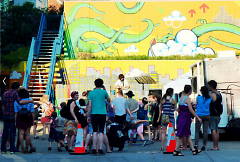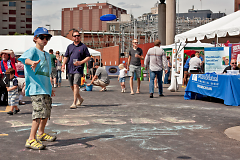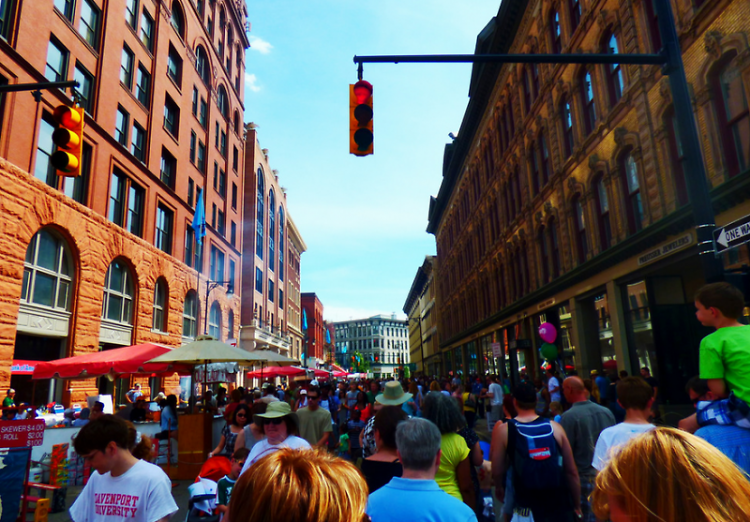
The Market presented by Avenue for the Arts 2014 /Ann-Marie Jurek

Local First Street Party 2014 /Eric Tank

Festival of the Arts 2014 /Ann-Marie Jurek

The Market presented by Avenue for the Arts 2014 /Ann-Marie Jurek

Local First Street Party 2014 /Eric Tank
Written by Kristopher Larson, AICP
I spend a lot of time thinking about demography. As a science, the field amounts to population measurement and planning - which, generally, means developing an understanding of how future generations will plan to settle in our community, our region, our nation and our world. One of the imperatives of planners is seeking to understand how our community will change – not simply in a physical form – but also in how the citizenry’s preferences will change. While everybody has preferences and opinions, the opinions en masse, particularly when evidenced through actions, help to provide insight into actual changes happening in our communities. These actions are the results of decisions that people make regarding the ways that they want to live.
Where people can live the ways they want to live, they end up loving where they live. Which begs the question: what can we as planners do to enable the evolving range of options they people want so that our community remains a place that people love living in?
Some of what is known about population changes has been well documented. Across America and here in Grand Rapids, people are moving downtown. Lots of them. Downtown’s population has increased by 188% from 1990 – 2010; over the same period, the entire population of the City of Grand Rapids increased by only 4.85%, and the entire United States grew by 24.1%. So as fast as the United States is growing, Downtown is growing much faster.
As a reflection of that dynamic, consider the amount of residential investment pouring in: there are currently more than 800 additional residential in the development pipeline representing hundreds of millions of dollar in new investment Downtown. Those 800+ units represent a 22% increase over the total amount of housing currently in Downtown – and it’s not enough. Developers are looking everywhere in Downtown for opportunities to build all types of residential product – from micro-units to affordable housing to high-end apartments – some have waiting lists that reach four digits. This investment is a measure of confidence in the future of our community to perform.
Considering the alternative, Downtown Grand Rapids is in a fortunate situation. The state’s perplexed, most populous city, Detroit, has lost over a million people since 1960. So as Michigan’s elected leaders earmark war chests of cash toward solving Detroit’s problems, the state’s second most populous city, Grand Rapids, keeps modestly chugging along, building a community around a sustainable model of investments in livability.
But as livable as we are today, what investments do we need to make to ensure that we’re considered livable tomorrow? What needs will need to be met to ensure that our younger generations – those that will power the workforce of tomorrow – find our city livable according to their preferences?
We’ve come to learn quite a bit about the reasons why people are choosing urban lifestyles, both in Grand Rapids and across the country. We certainly know that the way that Americans prefer to move is changing. A popular maxim to describe this phenomenon: “they’d rather text than drive” perfectly capitulates to allure of re-capturing time otherwise lost behind the wheel. As our eyes and minds are imprisoned by our smart phones, our needs to email, tweet, comment and rock some Candy Crush outweigh our desire to worry about oil changes or parallel parking. The percentage of Americans owning smart phones is also on the rise: according to Nielsen’s Digital Consumer Research, 65% of Americans in 2013 owned a smart phone – up from 44% in 2011. By way of comparison to other digital devices, smart phones are now more prolific than either video game console ownership (45%) or households with cable (54%).
Although it probably isn’t news to many anymore, it bears repeating that the average American aged 16-34 drove 23 percent fewer miles in 2009 than the average person in the same age group in 2001. Additionally, mobility trends have also affected the auto manufacturers: while people between 21-34 purchased 38 percent of new cars in 1985, they accounted to just 27 percent of new cars in 2010. As a nation of many demographic profiles – the results are similar across ages, races, and genders: downward. From 2008-2010, the total number of registered automobiles in the U.S. decreased by 4.5%; in California – historically one of the most auto-centric states – the total number of cars over the same period decreased by 10%. American driving, on a per person level, has decreased every year since 2005, a full 9.3% lower than its peak in 2005 and has retracted to levels comparable to that of 1994.
In the 1960s, the car may have been the ultimate symbol off individual freedom, but today that freedom fits in our pockets. Americans are choosing to structure their lives to afford themselves autonomy from their cars, and these trends are only expected to grow. In Los Angeles – in just his second year as Mayor – Mayor Garcetti recently rolled out a plan to turn sections of 40 streets into GREAT STREETS – friendlier and more accessible to all people, regardless of their chosen mode of transportation. Though Missing Persons once mused that ‘No one walks in LA’ it appears that the tides have turned even in the city supposedly designed around the car.
Mobility is but one area where we must take pause to consider our investments in city building, and there are others. With growth comes expanded needs for professional opportunities, essentials, and enjoyment. As we plan to position Downtown Grand Rapids to be one of the most livable and desirable neighborhoods in West Michigan, we’re compelled to consider those areas that people will prioritize when choosing to call this place home. We’ve got to continue our efforts to help people age in place – which means access to great neighborhood schools in Downtown is critical. That becomes a strategy to help hold on to the same people that are moving here today.
As our population grows, so will our ability to attract and support convenience and comparison retail goods – the measuring stick that many use to describe a vital urban neighborhood – but one that is rooted in economic feasibility and not public sector intervention. We’ve also got to think about issues related to recreation – those amenities that add value to our lives and smiles to our faces.
Livability will be a key focus of the recently launched Downtown Planning effort, bundled with planning for our riverfront in one convenient package with GR Forward. We’d love to know more about you and what you value in the place you call home, such that we can make Downtown one of the most dynamic neighborhoods in the city.
The Rapidian, a program of the 501(c)3 nonprofit Community Media Center, relies on the community’s support to help cover the cost of training reporters and publishing content.
We need your help.
If each of our readers and content creators who values this community platform help support its creation and maintenance, The Rapidian can continue to educate and facilitate a conversation around issues for years to come.
Please support The Rapidian and make a contribution today.